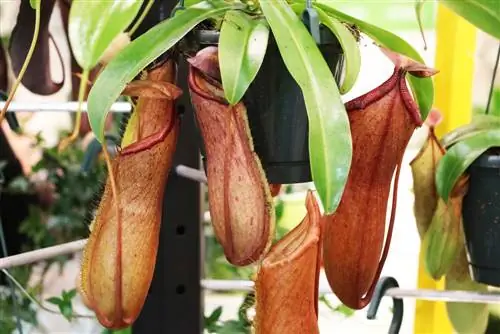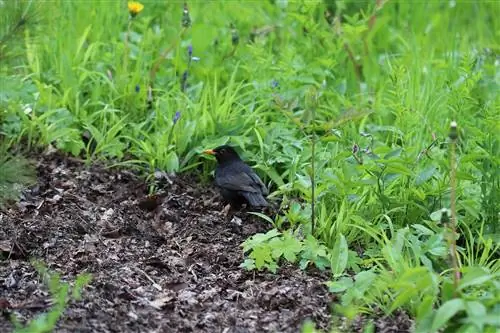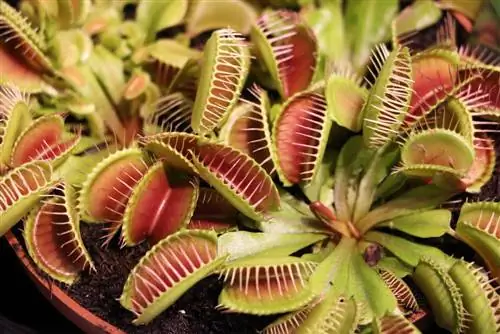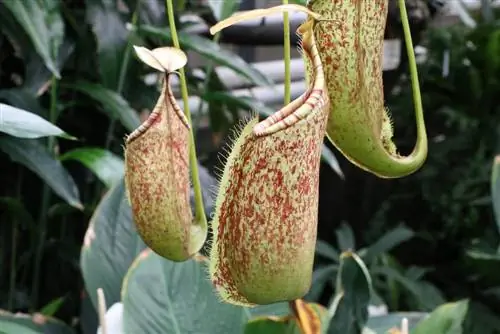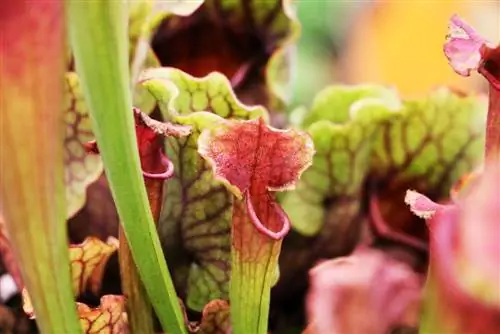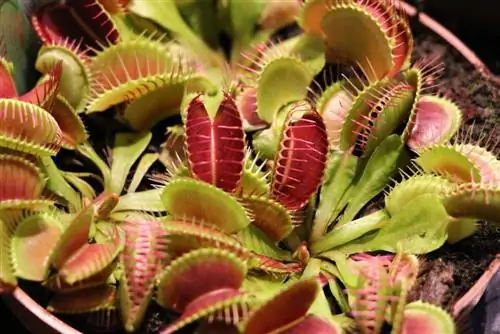- Author admin [email protected].
- Public 2023-12-17 03:39.
- Last modified 2025-01-24 12:45.
The pitcher plant is a real eye-catcher thanks to its passive insect traps. There are also unusual leaf shapes and a generally exotic look. In order for this to be preserved, the carnivorous plant, also known as Nepenthes, also requires special care and specialist knowledge about the needs of location and fertilization. If you want to optimally care for your exotic animal, you will find everything you need to know in the following instructions.
Species
Around 100 species of the pitcher plant genus are now known and new discoveries are always being made. The diversity of species is not surprising, as the plant spreads from lowlands to highlands and can be found from Australia to Sumatra. This gives those interested a large selection, but also means that there are significant differences in needs. The pitcher plants from the mountainous highlands in particular are difficult to handle and require a tropical climate during the day and cold temperatures at night. Anyone who wants to try their hand at Nepenthes as a beginner should therefore initially choose lowland species or hybrids, as these are much easier to care for. The following have proven particularly useful here:
- Nepenthes alata
- Nepenthes ventricosa
- Nepenthes rafflesiana
- Nepenthes truncata
- Nepenthes Ventrata
- Nepenthes Mixta
- Nepenthes Coccinea
Location
The location conditions for the pitcher plant depend heavily on its original origin. This applies to both temperature and humidity. Hybrids, like Nepenthes Mixta, are generally a little more undemanding and robust. In general, however, carnivorous plants require comparatively high humidity and a lot of heat. It may therefore be advisable to cultivate them in a terrarium or indoor greenhouse.
Tip:
If you don't want to increase the humidity up to 90 percent and can't offer extreme temperature fluctuations, you should choose breeding hybrids. Some of them are designed to thrive in normal indoor climates. In addition, hybrids are much more commonly available in stores.
Substrate
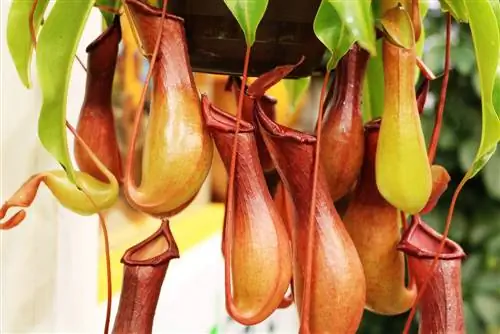
Just like the location, the type of pitcher plant is important here. A nutrient-poor, permeable soil with moderate storage capacity is suitable as a basis. The substrate must therefore be able to absorb and store water, but must not be wet and compact. The easiest way to choose the right substrate is to use special soil for carnivorous plants.
Depending on the needs of the respective Nepenthes species, this can be adjusted with the following additions:
- Perlite
- Coconut Fiber
- Quartz gravel
- Activated carbon
- Sphagnum moss
- Expanded Vermiculite
However, this requires sensitivity and appropriate knowledge. Beginners should therefore seek advice from specialist retailers.
Moisture
The pitcher plant hybrids mentioned can cope with normal humidity, others require a humidity of up to 90 percent and can therefore only be cultivated in a greenhouse, terrarium or florarium. It is therefore important to pay close attention when choosing.
Pouring
As mentioned, pitcher plants come from tropical areas - i.e. from a rainy climate. Accordingly, they need to be watered regularly, at least during the growth phase. The following factors are important:
- Use soft, low-lime water - for example rainwater
- Do not water with cold water
- Avoid dryness and waterlogging
- Better pour into the coaster
- Additionally spray regularly
Feeding and fertilizing
Since the pitcher plant is a carnivorous plant, feeding seems necessary. In fact, there are two ways to supply the Nepenthes with nutrients. The easiest option, especially for pitcher plants in the florarium, is to use a ready-made fertilizer. Orchid fertilizer has proven effective here. If you want to feed the pitcher plant or use it to destroy insects, you can only do so outside the florarium and in rooms where insects are occasionally present - or in the open field.
The insects are attracted to attractants in the cans and slide onto the smooth surfaces. The jugs themselves contain a liquid that is very acidic and also rich in enzymes. This can digest the flying and crawling animals and supplies the released nutrients to the plant. However, the Nepenthes does not depend on this or regular fertilization, as the substrate alone contains more nutrients than are available to the plants in their area of origin. However, if you want to experience feeding once in a while, you can completely save on fertilization and should also consider a few aspects:
- The food animals must be alive, insects found dead can harm the plant
- Insects should be selected in size to suit the pitchers
- Food animals that have been stunned by spray or otherwise chemically treated should not be given
- Feeding should not be done too often, i.e. about once a month during the growth phase
Tip:
Using tweezers ensures that the food animals can be placed specifically in the jugs and do not get “lost” in the apartment or in the florarium.
Intersection
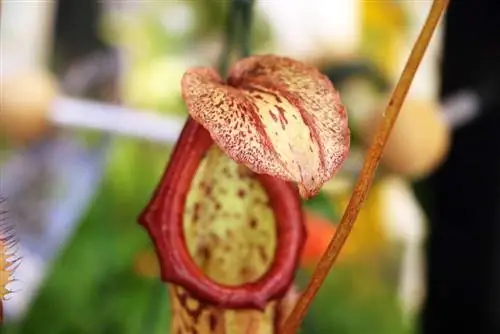
Occasionally, for example after feeding on larger insects, the pitchers of Nepenthes may wither and die. It is not absolutely necessary to remove them if they dry out.
However, dead plant debris can increase the risk of mold due to moist soil and high humidity. It is therefore safer to remove wilted and dried plant parts. Apart from that, cutting is not necessary for the pitcher plant.
Vessel
Most pitcher plants grow best in a shallow planter that can be hung or placed on a pedestal. This means the jugs can hang down slightly. A suitable shape of the planter is also important for the Nepenthes. The plants form dense root networks, but their roots are shallow. This means no deep pots are required. Vessels with a slightly larger diameter are better. In these, not only can the roots spread optimally, but also, as in nature, some cans can rest and others can hang down.
Repotting
Since the Nepenthes needs few nutrients, changing the soil to supply it is not often necessary. But it still has advantages. For example, regular repotting prevents germs or pests from multiplying in large numbers in the substrate. A soil change should therefore take place every two to three years. It is advisable to remove or rinse off as much of the substrate residue as possible. This must be done carefully and gently so as not to damage the roots.
Tip:
If the pitcher plant has thrived in the previous soil mixture, it should be remixed as best as possible. Components such as perlite or vermaculite can usually be recognized just as easily as sphagnum moss. If you are unsure, you should first visit a specialist retailer or nursery and, if necessary, have the substrate prepared accordingly.
Bloom
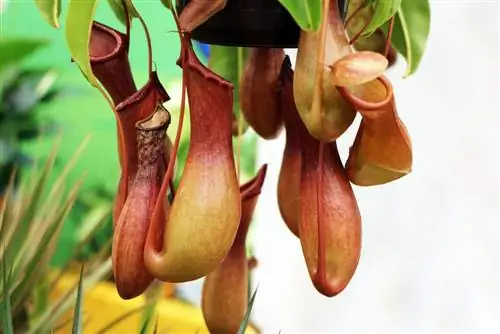
The pitcher plants have male and female flowers that - depending on the species - are at least 15 to 100 centimeters above the plants. They are fertilized by insects, but can also be specifically pollinated by hand. To do this, it is necessary to pick up the pollen from the male flowers with a fine brush or a cotton swab and introduce it into the female flowers. The male flowers have four to 24 stamens, while the female flowers have three to four carpels. After successful fertilization, capsules containing several hundred seeds are formed.
Tip:
The pitcher plant species can be propagated among each other. This means that pollen from one species can be used to fertilize another species.
Propagate
Since the pitcher plant produces seeds itself, this already provides a possibility for propagation. The seeds should be used directly and not dried and stored first. Even then, germination takes a long time and is difficult. This variant of reproduction should therefore only be attempted when the culture of the adult Nepenthes no longer causes any problems. Another way to propagate is to use cuttings. Head cuttings, which are cut off at the beginning of the growth phase in spring and immediately inserted into the substrate, are primarily suitable for this.
The cut is made on the trunk, in the area between two leaves, so that the longest possible stem can be inserted into the ground. The substrate must be kept slightly moist and the humidity must be carefully monitored so that the cutting can form new roots. Using leaf cuttings is also possible, but has a lower chance of success.
Wintering
With appropriate temperatures and regular spraying, the pitcher plant can be left outdoors in summer, but should of course be brought indoors in cooler weather. Here it must continue to be warm and moist as usual. It does not tolerate cool wintering. If you don't put the Nepenthes outdoors in the summer, you can cultivate them as usual all year round.
Typical care errors, diseases and pests
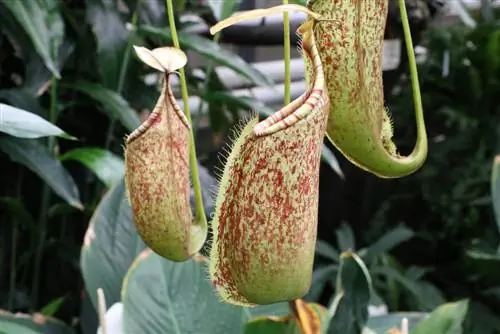
The pitcher plant does not have to worry about pests and, apart from root rot, it is also spared from diseases. Only errors in care can become a problem. Chief among them:
- Lack of humidity
- Using hard or cold water for watering and spraying
- Temperatures too low
- Overfertilization or feeding too frequently
- Too dark location
If the cultivation conditions of the pitcher plant are taken into account and the influences at the location are checked regularly, the risk of damage is very low. If growth is very slow, leaves or pitchers begin to wilt or dry out, care should be urgently checked and adjusted. There is no guarantee that the Nepenthes will be saved either, but if countermeasures are taken in a timely manner, the chances are good.

